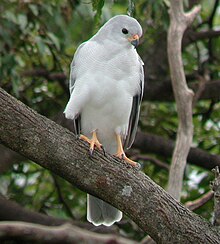Grey goshawk
| Grey goshawk | |
|---|---|
 |
|
| Scientific classification | |
| Kingdom: | Animalia |
| Phylum: | Chordata |
| Class: | Aves |
| Order: | Accipitriformes |
| Family: | Accipitridae |
| Genus: | Accipiter |
| Species: | A. novaehollandiae |
| Binomial name | |
|
Accipiter novaehollandiae (Gmelin, 1788) |
|
The grey goshawk (Accipiter novaehollandiae) the white morph of which is known as the white goshawk, is a strongly built, medium-sized bird of prey in the family Accipitridae.
The grey morph has a pale grey head and back, dark wingtips, barred grey breast and tail, and white underparts. The white morph is the only bird of prey in the world to be entirely white.
Grey goshawks are about 40–55 cm long, with wingspans of 70–110 cm. Females are much larger than males, weighing about 680 g. Males average 350 g.
The grey goshawk is found along the coasts of northern, eastern and south-eastern Australia, Tasmania and rarely Western Australia. The variable goshawk was previously considered a subspecies.
Their preferred habitats are forests, tall woodlands, and timbered watercourses.
Goshawks usually prey on mammals such as rabbits, possums, and bats. They may also eat birds, small reptiles, and insects. Females, due to their size, can catch larger prey than males.
Hunting is often done by stealth, but grey goshawks are willing to pursue their prey before catching it with their talons.
Grey and white goshawks interbreed freely. They partner for life, breeding from July to December. They nest in tall trees on a platform of sticks and twigs with a central depression lined with green leaves. The female lays a clutch containing 2 or 3 eggs, which are incubated for about 35 days. Chicks fledge 35–40 days after hatching.
The female is usually responsible for incubating the eggs and feeding the young. The male does most of the hunting.
State of Victoria (Australia)
...
Wikipedia

